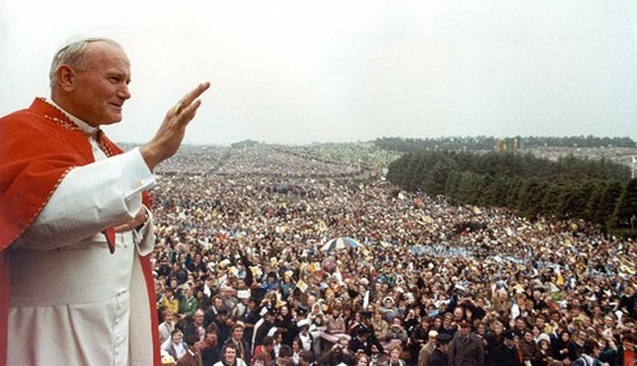It could take years before we know if the papal trip has been a success, writes David Quinn
And so, all 500,000 tickets available for the Pope’s Mass in Phoenix Park next month have been taken up. That is an impressive number by any reckoning, and especially in today’s very secular climate. An additional 100,000 in total will attend the papal events in Croke Park and Knock. But how should we measure the success of the Pope’s pending visit?
Well, numbers do matter. To this day, people refer to the massive numbers that turned out for Pope John Paul II in 1979 or for the Eucharistic Congress in 1932, or, for that matter, when a big music act is in town.
That 500,000 may be less than half the number that turned out for St John Paul almost 40 years ago, but insurance and health and safety considerations have limited the crowd to that size. If there were no limits, it’s quite possible another 200,000 would attend.
But obviously numbers are not everything because if they were, then the success of the 1979 visit would have been enormous. What counts, of course, is a lasting effect and on that basis that first papal visit was probably a failure.
Mind you, that is setting a very high bar for success. Can one visit on its own, no matter how important the person is, really set in motion a social, moral and spiritual revival?
When John Paul made his first visit as Pope to his native Poland, not long after his election, it did have a seismic impact. It helped to undermine the foundations of Polish communism and in turn of the whole of East European communion including in the Soviet Union itself.
However, the foundations were already cracking. It’s easy enough to say that now in hindsight, but something had been building for a long time. To mix my metaphors, John Paul lit a fuse that was already laid, albeit in part by the work of people such as himself over several decades. The Catholic Church in Poland acted as a very strong alternative to a totalitarian State, as a focal point of resistance.
When John Paul came here in 1979, the trends were very different. I was a teenager then and nominal Catholicism was already very widespread among my age group. Most of us went to Mass alright, but there was a lot of indifference around, a certain amount of hostility and very little ardent faith.
We all went to the Phoenix Park and we were glad to be there. It was an exciting event and an exciting time. But we barely talked about it afterwards, and the only thing any of us remembered the Pope saying was “young people of Ireland, I love you”, and that was in Galway. Asking the IRA on bended knee to give up violence probably registered also.
But his deeper messages had no impact on us and we were the generation that really set about secularising the country with gusto. Most of us secularised it passively, by stopping going to Mass and ceasing the practice of the faith, and some of us set out to do so systematically and ideologically.
What will happen after Pope Francis comes here? A social and spiritual revolution certainly won’t happen, short of a literal miracle. So instead the success of the visit will have to be measured in other ways.
For example, what will be the effect on vocations which are extraordinarily low, even by Western standards? Will even a dozen more men present themselves to train for the priesthood next year? It would really be dismal if that did not happen.
Will there be any measurable effect on Mass attendance, or at least a slowing of the downward trend?
Will currently practicing Catholics become more fervent in their faith? Will they pray more, get to know the Bible better, join their local branch of St Vincent de Paul?
Will Pope Francis succeed in his own terms by presenting a softer, less judgemental version of Christianity to people, one that seems more inviting than what appears to be currently on offer? (In fact, that harder, more authoritarian version of Catholicism has been gone for years.)
But a big measure of success must be the effect on family life. He is coming here for the World Meeting of Families, after all.
Focus
The focus of the meeting itself seems to be more on the day-to-day practicalities of family life than on the general condition of the family in modern societies, including the social conditions that give rise to more divorce, more cohabitation, more children growing up without the presence of a father, not to mention the ideological pressures coming from the likes of ‘gender ideology’ which pretends, among other things, that the gender or sex we claim to be is unrelated to our body.
If the meeting and the visit of Pope Francis is to have a lasting and measurable impact, we are most likely to see it over the long-term in the success or otherwise of families in passing on the Catholic, Christian faith to their children.
This is an extremely challenging task, as difficult as passing on the Irish language from generation to generation.
When a language is not spoken in the home, it is much less likely to be learnt by the children. Likewise, if the language of Faith is not heard at home, and if children don’t see their parents living the Faith, then they are also much less likely to acquire it themselves.
What has to happen for the visit to succeed is for parishes to do what they can to create an immersive Faith environment that can help families to grow their Faith and grow their children in that Faith.
Over time, this ought to bear fruit. We won’t see it next year or the year after, but in 10 and 20 years’ time. If we see a growing minority of young people living out the Faith well, then we will know that the visit was a success.


 David Quinn
David Quinn Pope St John Paul II greeting the crowd in the Phoenix Park during the 1979 papal visit to Ireland.
Pope St John Paul II greeting the crowd in the Phoenix Park during the 1979 papal visit to Ireland. 